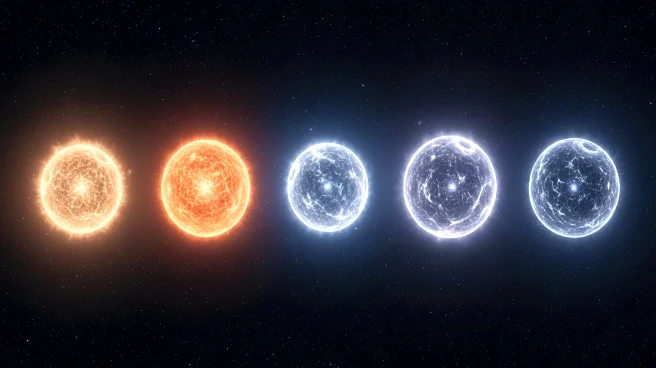What is the story about?
What's Happening?
Astronomers are investigating the number of star generations that preceded the formation of the Sun and its solar system. The Sun, which began forming approximately 4.6 billion years ago, is believed to be a third-generation star. This classification is based on the presence of heavy elements in the Sun, which were created in previous generations of stars. Population III stars, the first generation, were massive and short-lived, enriching their surroundings with heavy elements. Population II stars formed in regions with low enrichment, while Population I stars, like the Sun, formed in areas with higher metallicity. Recent discoveries, such as the star SDSS J0715-7334 in the Large Magellanic Cloud, have provided insights into the metallicity of stars, although none have been found to be truly pristine.
Why It's Important?
Understanding the generational history of stars is crucial for comprehending the chemical composition of celestial bodies and the formation of planetary systems. The presence of heavy elements is essential for the formation of rocky planets, like Earth. Stars with higher metallicity are more likely to host planets, impacting the search for habitable worlds. This research also sheds light on the processes of star formation and the evolution of galaxies, contributing to our knowledge of cosmic history and the conditions necessary for life.
What's Next?
Future research aims to identify truly pristine Population III stars, which would provide a clearer picture of the early universe's conditions. Astronomers will continue to study the metallicity of stars and their environments to better understand the star formation process. Advanced observations of metal-poor galaxies and distant gas clouds may reveal more about the enrichment history of the universe. These efforts will enhance our understanding of the universe's evolution and the potential for life beyond Earth.
Beyond the Headlines
The study of star generations has ethical and philosophical implications, as it touches on the origins of life and the universe. It challenges our understanding of cosmic evolution and the interconnectedness of celestial phenomena. The research also highlights the limitations of current technology and the need for more advanced methods to explore the universe's history. As scientists delve deeper into the cosmos, they confront questions about the nature of existence and humanity's place in the universe.
AI Generated Content
Do you find this article useful?















